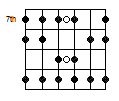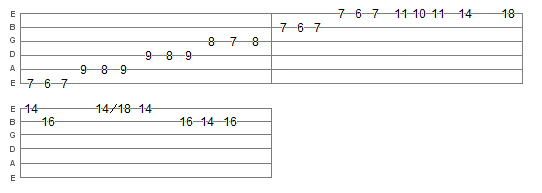Tuesday Night at the Improv
Recently, I was thinking of ways to teach my students better improvisation skills. Some were catching on to what I was teaching, but others seemed to not have a creative bone in their body. After a bit of brainstorming, I realized it was something they missed when I was teaching scales.
Take the C major scale below. You can play every note, you can play the pentatonic, or you can play random melodies. There is so much you can do, you just have to experiment. I told my students “Keep it simple. Most solos sound complex because the guitarist took something simple, built upon it, practiced it until they could build up the speed that it’s being played at, and what you hear sounds someone who is totally shredding the guitar when they are hardly putting in any effort into playing the solo.”
 My challenge was to come up with something “from string to string”, not “back and forth between the strings”. One student saw what I was looking for. He took the scale, then selected the notes shown in red below:
My challenge was to come up with something “from string to string”, not “back and forth between the strings”. One student saw what I was looking for. He took the scale, then selected the notes shown in red below:
 Now that he had the notes he was going to use, how would he play these from string to string; meaning playing from A to D to G to B instead of going back and forth between the strings? Below is the lick he came up with:
Now that he had the notes he was going to use, how would he play these from string to string; meaning playing from A to D to G to B instead of going back and forth between the strings? Below is the lick he came up with:
For those of you Foreigner fans, this is similar to the solo for Cold As Ice:
Both solos, although similar, are also simple. There are no shifts back and forth from strings on the run up, there are no bends or unison bends, and there are no chord shapes. If my student would have kept the same pattern going, he could have created something that sounds very similar to Cold as Ice, but with a different spin. This is how solos are created. You take patterns, whether someone has already done it, or if you find it’s something new, and expand upon it. Eventually, you have something unique to you that you can play in any key.
Once my students realized that they were missing patterns within the scales they had been practicing, and that they can take those patterns, develop a lick, or a series of licks, they can then put them together to form a solo. This is truly what improvising is all about. When playing against backing tracks, these students became more confident in their solos.
Posted on September 17, 2014, in backing tracks, guitar, music, music theory, play guitar, scales, solo improvising, tablature and tagged backing tracks, guitar, guitar tablature, guitar tabs, music, Music theory, play guitar, real tabs, scales, solo improvising, tablature, tabs. Bookmark the permalink. Leave a comment.



Leave a comment
Comments 0